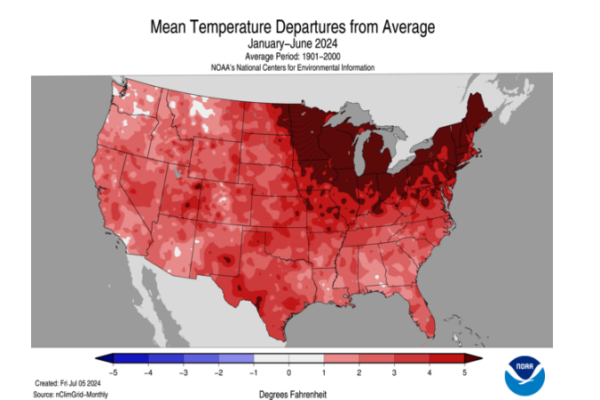
Half of the 50 states, stretching from Minnesota across the Great Lakes to New England, have experienced record and near-record year-to-date temperatures.
The first six months of 2024 have been the warmest on record.
Among these disasters were five tornado outbreaks, two winter storms, and two hail storms. The global temperature remained 2.32 degrees above average, while the contiguous United States saw temperatures 3.4 degrees Fahrenheit above average.
Russ Vose, NOAA Chief of Climate Monitoring and Assessment, noted that June marked the 13th consecutive record-warm month globally, with temperatures 2.20 degrees Fahrenheit above average. In the United States, June was the second-warmest on record, with temperatures 3.4 degrees Fahrenheit above average.
Arizona and New Mexico set record average temperatures for June, while California, Nevada, Utah, Colorado, and Florida experienced near-record averages. Additionally, most of the region saw significantly above-average precipitation, with Minnesota, Wisconsin, and Michigan recording the highest above-average levels.
Virginia had its driest June on record, while North Carolina and other states experienced below-average rainfall. Virginia was the only state to set a new record for lack of precipitation.
The NOAA’s global records date back to 1850, and U.S. records date back to 1895.
Looking ahead, the NOAA predicts a 59 percent chance of 2024 becoming the hottest year on record.
NOAA meteorologist Core Baggett stated that above-average heat and rainfall are expected to continue through August, September, and October, particularly in Florida and most southern and eastern states due to an active hurricane season.
While drought conditions in the Appalachian states are predicted to improve, the West is expected to become drier, with drought conditions persisting and developing in several states.
The NOAA also issued a La Nina watch, with a high chance of it persisting into the winter of 2025.
The NOAA’s monthly climate report for June highlighted the first named storms of the hurricane season and ongoing wildfires, particularly in California and other western states.
So far, 15 disasters have caused over a billion dollars each in damages, tracking slightly ahead of the record set in 2023.
Mr. Vose emphasized the increase in exposure to extreme events due to population growth in vulnerable areas.
The NOAA’s U.S. Climate Report and Billion-Dollar Disaster Summary for July will be released on Aug. 8.





